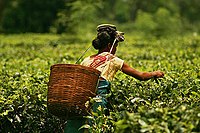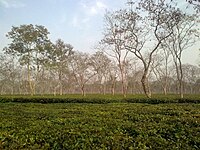Assam tea
This article needs additional citations for verification. (January 2010) |
| Assam | |
|---|---|
 | |
| Type | Black |
| Other names | NA |
| Origin | Assam, India |
| Quick description | Brisk and malty with a bright color and a touch of tickiness. |
Assam tea is a black tea named after the region of its production, Assam, in India. Assam tea is manufactured specifically from the plant Camellia sinensis var. assamica (Masters).[1][2] This tea, most of which is grown at or near sea level, is known for its body, briskness, malty flavour, and strong, bright colour. Assam teas, or blends containing Assam, are often sold as "breakfast" teas. For instance, Irish breakfast tea, a maltier and stronger breakfast tea, consists of small-sized Assam tea leaves.[3]
The state of Assam is the world's largest tea-growing region, lying on either side of the Brahmaputra River, and bordering Bangladesh and Burma (Myanmar). This part of India experiences high precipitation; during the monsoon period, as much as 10 to 12 inches (250–300 mm) of rain per day. The daytime temperature rises to about 96.8F (36 °C), creating greenhouse-like conditions of extreme humidity and heat. This tropical climate contributes to Assam's unique malty taste, a feature for which this tea is well known.
Though Assam generally denotes the distinctive black teas from Assam, the region produces smaller quantities of green[4] and white teas as well with their own distinctive characteristics.[5][failed verification]
Historically, Assam has been the second commercial tea production region after southern China. Southern China and Assam are the only two regions in the world with native tea plants.
Introduction to the West

The introduction of the Assam tea bush to Europe is attributed to Robert Bruce, a Scottish adventurer, who apparently encountered it in the year 1823. Bruce reportedly found the plant growing "wild" in Assam while trading in the region. Maniram Dewan directed him to the local Singpho chief Bessa Gam.[6] Bruce noticed local tribesmen (the Singhpos) brewing tea from the leaves of the bush and arranged with the tribal chiefs to provide him with samples of the leaves and seeds, which he planned to have scientifically examined. Robert Bruce died shortly thereafter, without having seen the plant properly classified. It was not until the early 1830s that Robert’s brother, Charles, arranged for a few leaves from the Assam tea bush to be sent to the botanical gardens in Calcutta for proper examination. There, the plant was finally identified as a variety of tea, or Camellia sinensis, but different from the Chinese version (Camellia sinensis var. sinensis).
Sales in the United Kingdom

The intervention of the colonising British East India Company was realised through a body of 'experts' constituting the Tea Committee (1834) to assess the scientific nature and commercial potential of Assam tea. The adherence of the members of the committee to the Chinese ideal (in terms of the plant and the method of manufacture) led to the importation of Chinese tea makers and Chinese tea seeds to displace the "wild" plant and methods obtained in Assam. After a period, however, a hybridized version of the Chinese and Assam tea plants proved to be more successful in the Assam climate and terrain.
By the late 1830s, a market for Assam tea was being assessed in London; and the positive feedback led the East India Company to inaugurate a long drawn process of dispossession of agricultural land and forest commons through the infamous 'Wasteland Acts' allowing significant portions of the province by private capital to be transformed into tea plantations. The close symbiotic relationship of the colonial state and plantation capitalism through the colonial period is most succinctly captured in the term Planter-Raj.
Production

The cultivation and production of Assam tea in the first two decades (1840–1860) were monopolised by the Assam Company, which operated in districts of Upper Assam and through the labour of the local Kachari community. The success of the company and the changes in colonial policy of offering land to the tea planters (Fee simple rules) led to a period of boom and expansion in the Assam tea industry in the early 1860s, but these could not necessarily be translated into a dramatic shift in production (from China to Assam) due to the "makeshift" nature of plantations, poor conditions of life on plantation (huge rates of mortality and desertion), and also at times the presence of pure speculative capital with no interest in tea production. Most of the tea estates in Assam are the members of the Assam Branch Indian Tea Association(ABITA),which is the oldest and most prominent body of tea producers of India.
Separate time zone
Tea gardens in Assam do not follow the Indian Standard Time (IST), which is the time observed throughout India and Sri Lanka. The local time in Assam's tea gardens, known as "Tea Garden Time" or Bagantime, is an hour ahead of the IST.[7] The system was introduced during British days keeping in mind the early sunrise in this part of the country.
By and large, the system has subsequently been successful in increasing the productivity of tea garden workers as they save on daylight by finishing the work during daytime, and vice-versa. Working time for tea labourers in the gardens is generally between 9 a.m. (IST 8 a.m.) to 5 p.m. (IST 4p.m.) It may vary slightly from garden to garden.
Noted filmmaker Jahnu Barua has been campaigning for a separate time zone for the northeast region.[7]
Geography


The tea plant is grown in the lowlands of Assam, unlike Darjeelings and Nilgiris, which are grown in the highlands. The Assam tea bush grows in a lowland region, in the valley of the Brahmaputra River, an area of clay soil rich in the nutrients of the floodplain. The climate varies between a cool, arid winter and a hot, humid rainy season—conditions ideal for growing tea. Because of its lengthy growing season and generous rainfall, Assam is one of the most prolific tea-producing regions in the world. Each year, the tea estates of Assam collectively yield approximately 1.5 million pounds (680,400 kg) of tea.
Assam tea is generally harvested twice, in a “first flush” and a “second flush.” The first flush is picked during late March. The second flush, harvested later, is the more prized “tippy tea,” named thus for the gold tips that appear on the leaves. This second flush, tippy tea, is sweeter and more full-bodied and is generally considered superior to the first flush tea. The leaves of the Assam tea bush are dark green and glossy and fairly wide compared to those of the Chinese tea plant. The bush produces delicate white blossoms.
See also
- Tea
- Nilgiri tea
- Darjeeling tea
- Earl Grey tea
- Green tea
- Tea Board of India
- Coolie
- Assam
- Tea-tribes
- Indian Tea Association
- Tocklai Tea Research Institute
References
Citations
- ^ Tea Classification from Tea Research Association, Toklai (retrieved 2009/03/25)
- ^ ITI Standard Report Page for Camellia sinensis var. assamica retrieved on 2009-03-28.
- ^ (Campbell 1995, p. 203)
- ^ (Pettigrew 2004, p. 106)
- ^ Goswami, Roopak (2011-12-29). "Assam CTC fetches record price". The Telegraph.
- ^ Nitin Aant Gokhale (1998). The hot brew: the Assam tea industry's most turbulent decade, 1987–1997. Spectrum Publications. p. 4. ISBN 978-81-85319-82-7.
- ^ a b "Assam tea gardens an hour 'ahead' of India – ZeeNews.com". Retrieved 18 July 2013.
Sources
- Campbell, Dawn (1995). The Tea Book. Pelican Publishing. Retrieved March 2, 2013.
{{cite book}}: Invalid|ref=harv(help) - Kiple, Kenneth F.; Ornelas, Kriemhild C. (October 2000). The Cambridge World History of Food (Volume 1). Cambridge University Press. ISBN 0-521-40216-6.
- Pettigrew, Jane (2004). The Tea Companion. Running Press. Retrieved March 2, 2013.
{{cite book}}: Invalid|ref=harv(help)
External links
- Social perspective of labour legislation in India 1859–1932: As applied to tea plantations (1987) by Ramkrishna Chattopadhyay
- Producing tea coolies? – Work, life and protest in the colonial tea plantations of Assam, 1830s- 1920s (2011) by Nitin Varma
- Tea-Garden Coolies in Assam (1894) by The Rev. Charles Dowding
- The savaras of Mancotta: A study on the effects of tea industry on the tribal life (1975) by Ramendra Kumar Kar
- The early history of the Tea industry in North-East India (1918) by Harold Mann
- The Tea industry in India :A Review of Finance and Labour, and a guide for Capitalists and Assistants (1882) by Samuel Baildon
- Recruitment of labour for Tea gardens in Assam (1909) by JF Gruning
- The Tea Planter's vade mecum(1885) by Tea Gazette
- Tea Planter's Life in Assam (1884) by George Barker
- The Cultivation & Manufacture of Tea (1883) by Edward Money
- The Tea soils of Assam and Tea Manuring (1901) by Harold H Mann
- Tea Producing Companies of India and Ceylon (1897)
- The Tea Industry (1921) by J C Kydd
- The Recollections of a Tea Planter (1937) by W M Fraser
- Assam Planter (1945) by A R Ramsden
- [1] Images of 19th century Assam plantations from Smithsonian Institution
- Tea History Plant Cultures
